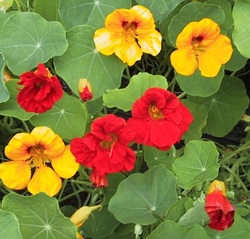
Nasturtium (Tropaeolum majus) is an annual with edible leaves, flower and seeds. A useful companion, it repels insects that damage squash, cucumber, broccoli and cabbage plants.
Plant of the Month, February, 2013
In the summer of 2010, Bath Gamma Garden Club created an herb garden next to the Saltbox House at Hale Farm and Village. This year, our Plant of the Month articles will highlight some of the more unusual and useful plants in the Salt Box garden – plants that may be suitable for your home garden like the nasturtiums shown here.
In the summer of 2010, Bath Gamma Garden Club created an herb garden next to the Saltbox House at Hale Farm and Village. This year, our Plant of the Month articles will highlight some of the more unusual and useful plants in the Salt Box garden – plants that may be suitable for your home garden like the nasturtiums shown here.
As you may know, Bath Township is one of the earliest settlements in what was then the Connecticut Western Reserve. Settled in 1810 by Jonathan Hale, the 500-acre property was acquired for $1,250 and is now the site of Hale Farm and Village on Oak Hill Road, Bath Township, in the Cuyahoga Valley.
As was the style in the colonial period, the Salt Box herb garden is modest in size with four raised beds and graveled pathways in between. Nevertheless, the garden includes many of the necessary culinary, medicinal, dye and housekeeping plants which would have been basic to the colonial settlers who came to live in Ohio.
Single-purpose gardens were unusual in early American settlements; instead, most gardens included fruits, herbs, ornamentals, vegetables, and often plants for dying cloth and repelling pests. Fencing around a garden is also typical of this period, since the central village green would likely be used for grazing cows and sheep. Fences were either wood stockade, wattle (closely spaced upright sticks with flexible branches woven through them), or picket as we see near the Salt Box garden. While fence styles varied, each was intended to ward off foraging livestock. (Even ducks and geese can do a lot of damage to a kitchen garden!)
We’ll include some history on the development of the garden, the historical uses of the plants, and background on how Hale Homestead fit into the agricultural history of the Connecticut Western Reserve.
The Bath Gamma Garden Club provides Plant of the Month articles as part of its mission to provide gardening information to all. The club was founded in 1957 to share our interest in and love of gardening, promote the beautification of Bath and protect native plants. Call club president Patti Sinar at 330-659-3289 for more information about attending and joining.
As was the style in the colonial period, the Salt Box herb garden is modest in size with four raised beds and graveled pathways in between. Nevertheless, the garden includes many of the necessary culinary, medicinal, dye and housekeeping plants which would have been basic to the colonial settlers who came to live in Ohio.
Single-purpose gardens were unusual in early American settlements; instead, most gardens included fruits, herbs, ornamentals, vegetables, and often plants for dying cloth and repelling pests. Fencing around a garden is also typical of this period, since the central village green would likely be used for grazing cows and sheep. Fences were either wood stockade, wattle (closely spaced upright sticks with flexible branches woven through them), or picket as we see near the Salt Box garden. While fence styles varied, each was intended to ward off foraging livestock. (Even ducks and geese can do a lot of damage to a kitchen garden!)
We’ll include some history on the development of the garden, the historical uses of the plants, and background on how Hale Homestead fit into the agricultural history of the Connecticut Western Reserve.
The Bath Gamma Garden Club provides Plant of the Month articles as part of its mission to provide gardening information to all. The club was founded in 1957 to share our interest in and love of gardening, promote the beautification of Bath and protect native plants. Call club president Patti Sinar at 330-659-3289 for more information about attending and joining.

 RSS Feed
RSS Feed